Experimental Technologies
Several brand new or next-generation technologies are riding aboard the Mars 2020 spacecraft. Two of these (MOXIE and the Ingenuity Mars Helicopter) are officially designated technology demonstrations – experiments that seek to prove a first-of-their-kind capability, with limited scope. Previous examples of these groundbreaking experimental technologies include the Mars Pathfinder mission and its rover (Sojourner), the Mars Cube One (MarCO) CubeSats that flew by Mars, and the NASA-sponsored rocket planes and lifting body vehicles that paved the way for the space shuttle. The success of these technology demonstrations is not connected to the overall success of the Perseverance rover and the Mars 2020 mission.
MOXIE (Mars Oxygen ISRU Experiment)
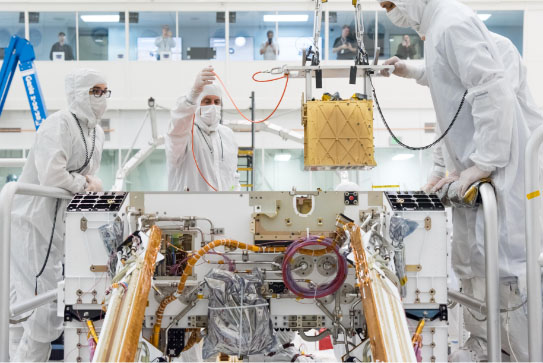 Image credit: NASA/JPL-Caltech | Full image and caption
Image credit: NASA/JPL-Caltech | Full image and caption
Located inside the body of the Perseverance rover, MOXIE will test technology that converts carbon dioxide in the Martian atmosphere into oxygen. The “I” in MOXIE stands for “in-situ resource utilization,” or ISRU – the concept of using resources found where a spacecraft lands rather than bringing those resources from Earth.
More information about MOXIE is available in the Payload Instruments section of this press kit.
MEDLI2 (Mars Entry, Descent, and Landing Instrumentation 2)
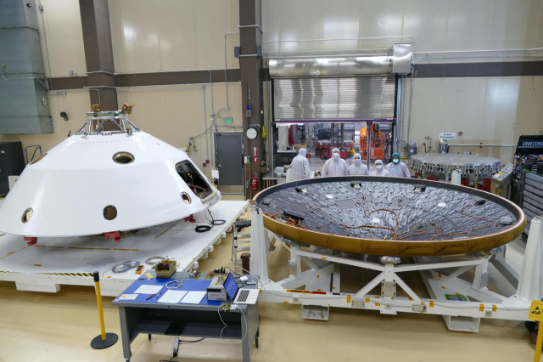 Image credit: NASA/JPL-Caltech/Lockheed Martin Space | Full image and caption
Image credit: NASA/JPL-Caltech/Lockheed Martin Space | Full image and caption
Based on an instrument flown on NASA’s Mars Science Laboratory (MSL) mission, which landed the Curiosity rover in 2012, MEDLI2 is a next-generation sensor suite that collects temperature, pressure, and heating measurements on the heat shield and back shell during entry, descent, and landing. Data collected by MEDLI2 will help engineers validate their models for designing future systems (both robotic and crewed) for entry, descent, and landing systems.
MEDLI2 is a Game Changing Development project led by NASA’s Space Technology Mission Directorate, with support from the Human Exploration and Operations Mission Directorate and Science Mission Directorate. The project is managed at NASA Langley Research Center in Hampton, Virginia, and implemented in partnership with NASA’s Ames Research Center in California’s Silicon Valley and NASA’s Jet Propulsion Laboratory in Southern California.
Find more information about MEDLI2 in this story.
Ingenuity Mars Helicopter
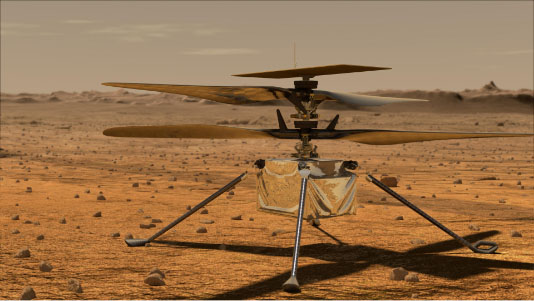 Image credit: NASA/JPL-Caltech | Full image and caption
Image credit: NASA/JPL-Caltech | Full image and caption
Weighing just about 4 pounds (1.8 kilograms), the Ingenuity Mars Helicopter is a small, autonomous rotorcraft designed to test – for the first time – powered, controlled flight in the thin Martian atmosphere. This lightweight helicopter does not carry any science instruments.
Ingenuity’s performance during its experimental test flights will help NASA make decisions about small helicopters for future Mars missions, where they could perform in a support role as robotic scouts, surveying terrain from above, or as full standalone science craft carrying instrument payloads. Taking to the air would give scientists a new perspective of a region’s geology and allow them to peer into areas too steep or slippery to send a rover. In the distant future, they might even help astronauts explore Mars.
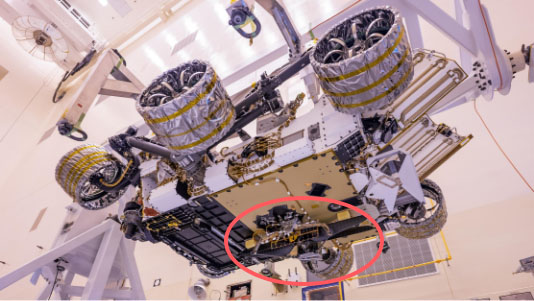 The Mars Helicopter Delivery System holds the Ingenuity Mars Helicopter to the underside of Perseverance. Image credit: NASA/JPL-Caltech | Full image and caption
The Mars Helicopter Delivery System holds the Ingenuity Mars Helicopter to the underside of Perseverance. Image credit: NASA/JPL-Caltech | Full image and caption
The Mars Helicopter Delivery System – designed collaboratively by Lockheed Martin Space and JPL’s Mars 2020 and helicopter teams – attaches the helicopter to the belly of the rover for the journey to the Red Planet. This system protects Ingenuity from debris during landing and will deploy the helicopter onto the Martian surface in the months after landing.
Also installed in Perseverance is the Mars Helicopter Base Station. This station carries computers that monitor and regulate helicopter systems while it is attached to the rover and the communications gear that – once the helicopter deploys to the surface – stores and routes communications between Ingenuity, Perseverance, and Earth.
For more on Ingenuity, read the Ingenuity press kit.
More on Spacecraft
-
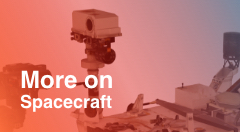
Perseverance Rover
Learn more about this part of the spacecraft
-

Getting to Mars
Learn more about this part of the spacecraft
-
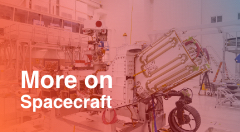
Power
Learn more about this part of the spacecraft
-
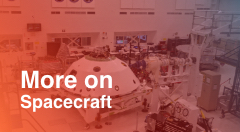
Telecommunications
Learn more about this part of the spacecraft
-
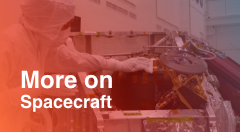
Biological Cleanliness
Learn more about this part of the mission
-

Experimental Technologies
Learn more about these technologies



